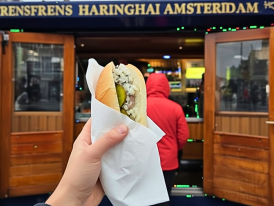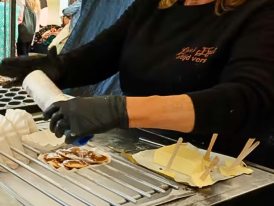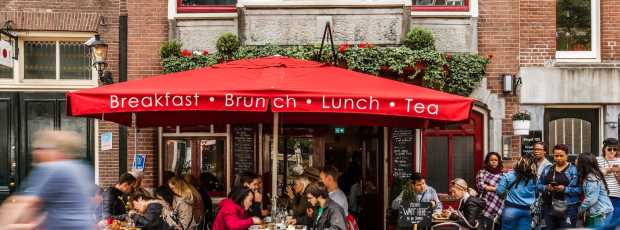Anna was fantastic, she showed us all that we wanted and things that we would have never known to look for!Robert, Amsterdam,2025
Table Of Contents
- Signature Dishes and Local Classics Worth Trying
- Global Food Scene and Diversity, Shaped by History
- Street Food and Casual Eats That Locals Love
- Sweet Treats and Desserts to Savor
- Drinks and Local Beverages, From Tradition to Today
- Foodie Neighborhoods and Markets to Explore
- Seasonal Specialties and the Flavors of Each Season
- Overrated Food Experiences: What to Skip and Where to Go Instead
- Practical Tips for Eating in Amsterdam
- Frequently Asked Questions about What to Eat in Amsterdam
- Discovering the True Taste of Amsterdam
There’s a moment in Amsterdam when the smell of onions sizzling in oil lures me to a stall, where locals smile and wave me over. It’s the exact moment I know I’m about to taste something unforgettable. I’ve spent fifteen years chasing that feeling, following my nose through markets, small eateries, and corners of the city where every dish tells a story. Food in Amsterdam runs deeper than stroopwafels and cheese wheels. The best meals happen where Indonesian aunties press roti by hand, where brown café owners remember your jenever preference, and where corner fry stands serve the same families for years.
This is my Amsterdam food guide, built from market mornings and late-night snacks, not lists.

Fresh herring being prepared at Stubbe’s Haring and people waiting for their herring broodje
Amsterdam’s food culture is shaped by centuries of maritime trade and Dutch history, colonial ties, and waves of migration across the Netherlands. These influences gave rise to flavors like Indonesian spice pastes, Surinamese curry blends, and Turkish breakfast bread, all now essential to Dutch tables. In this city, the real food doesn’t just happen in high-end restaurants. It lives in small kitchens, where kids do homework while dinner simmers. When you visit, dig deep and eat what locals eat. The best Amsterdam experiences show up when you follow the paths less traveled and step into the city’s food heritage.
Signature Dishes and Local Classics Worth Trying
These are the foundation dishes that define how Amsterdam eats, from centuries-old traditions to comfort plates I return to again and again. Whether you are a first-time visitor or an experienced food lover, this section will serve as your Amsterdam food guide and awaken your taste buds.
Raw Herring: The Proper Way
Raw herring is not sushi. It is salt-cured and gently matured, closer to gravlax than raw fish. You eat it two ways. Grab the fish by the tail and lower it into your mouth, or order a broodje haring on a soft bun with sliced pickles and diced raw onions.

Broodje haring served at Frens Haringhandel near Koningsplein, with diced onions and pickles
My first choice is Stubbe’s Haring by the Singel bridge because I can lean on the rail and people-watch while I eat. If I am crossing town, I stop at Frens Haringhandel by Koningsplein and walk it to the tram. In mid-June, when Hollandse Nieuwe lands across the Netherlands, a friend from De Pijp texts me to meet at Albert Cuyp Market for the first tray, extra onions, eaten standing so nothing drips on our sleeves. On Fridays, I swing through Dappermarkt before noon for a second round because I have no self-control.
Bitterballen: Beyond Frozen Standards
Bitterballen are bite-sized croquettes with a silky meat ragout inside, fried until the shell shatters and the center flows like savory custard. Many cafés use frozen trays. The places locals love make theirs in-house and serve them hot with sharp mustard. Think of them as Dutch meatballs you eat with your fingers.

Plate of bitterballen with mustard outside Café ’t Smalle with a nice view of the canal
When I want that first burn-the-tongue bite, I sit in the canal-side room at Café ’t Smalle and order a small jenever to keep the plate company. If it is packed or raining hard, I tuck into Café Thijssen because the room hums at borrel hour and the staff pour without fuss. A brewer friend swears the mustard there lands sharper, so I test the theory often.
Dutch Pancakes: Dinner, Not Dessert
Pannenkoeken are plate-sized and thin, cooked in butter, closer to a hearty crêpe than a breakfast stack. We eat them as a meal, with bacon, cheese, or apple baked in or piled on top. When I host, we split two plates. One bacon and cheese baked in. One apple with cinnamon sugar.

Bacon-and-cheese and strawberries and cream pannenkoek at Upstairs Pannenkoekenhuis
For old Amsterdam creaks and charm, I climb the steep stairs to Upstairs Pannenkoekenhuis and ask for a table by the window if it is free. When friends bring kids or we are coming from Vondelpark, De Vier Pilaren is our meet-up because the room is easy, plates land fast, and there is a poffertjes griddle outside for anyone who claims they are not hungry. These two are the pancake restaurants I trust.
Pea Soup: Winter’s Thick Comfort
Erwtensoep, or snert, should be sturdy enough to hold a spoon, built on split peas and root veg, with rookworst and a slice of roggebrood on the side.

Bowl of erwtensoep with rookworst and a good beer at Café ’t Papeneiland
On cold afternoons, I take a corner table at Café ’t Papeneiland and thaw my hands on the bowl before I start. If the front room is full, I am happy at the bar where the conversation is slower and the soup stays hot. At home, I sometimes park it next to a scoop of mashed potatoes because the extra starch makes the gravy cling the way I like in January.
Dutch Cheese: From Market Cubes to a Real Board
Dutch cheese shows up everywhere, from borrel bowls of cubes with sharp mustard to a short cheese board after dinner. I like to taste one young, one aged, and one flavored, so you get the range from milky to crystalline.

All the cheese you could ever want at De Kaaskamer van Amsterdam in the Jordaan
For shopping, I meet friends at De Kaaskamer van Amsterdam in the Jordaan, build a small board with pickles and rye, then carry it to a canal bench if the weather behaves. When family visits, Reypenaer Tasting Room does a guided flight that makes the differences click without the stage show. Some of the best restaurants in Amsterdam start a meal with cheese and bread because simple and right makes all the difference. stage show.
Kibbeling: Fish Fry Done Right
Kibbeling is bite-sized battered fish, usually cod or pollock, fried so the edges crackle and the middle stays juicy. You get a wedge of lemon and a pot of ravigote or tartar. I dip once, squeeze citrus, then eat the first piece too fast.

Freshly fried kibbeling in a paper tray at Dappermarkt
If I am in De Pijp, I head for a Volendammer counter at Albert Cuyp and ask for an extra lemon. In Oost, I will take a cone at Dappermarkt and eat it while walking. On lazy weekends, friends text the words “Ten Katemarkt kibbeling,” and that is the plan. We stand at a high table, compare sauces, and pretend we will share the last piece.
Stamppot: Mash, Greens, and Rookworst
Stamppot is winter on a plate. Mashed potatoes folded through greens, usually boerenkool, andijvie, or zuurkool, with pan gravy and slices of smoky rookworst. I like it when the mash stays a little lumpy so it holds the jus.

Boerenkool stamppot with rookworst served at Moeders. The walls are covered with framed photos
For the full nostalgic spread, I book Moeders and sit under all those family photos, then order boerenkool stamppot with mustard on the side. On quiet nights, I make a small pot at home and invite a neighbor to bring the rookworst. We eat slowly and let the evening take its time.
Looking for a Private City Experience in Amsterdam?
Explore the city with a local who plans a private day just for you; no groups, no scripts.
Global Food Scene and Diversity, Shaped by History
Amsterdam’s international food story comes from ships, migration, and neighbors teaching neighbors to cook across the Netherlands. When visiting Amsterdam, let immigrant kitchens lead your route. Follow immigrant kitchens and you’ll find the hidden gems in Amsterdam that most guides miss.
Indonesian Heritage: Beyond Tourist Rice Tables
From the era of the Dutch East Indies came spice pastes and comfort rituals that still live in our kitchens. I still enjoy a careful rice table now and then, but most days I order a few focused plates. On Utrechtsestraat, Tujuh Maret does the rijsttafel without theater. Ask for fewer dishes and more depth. For a polished room, Restaurant Blauw in Oud-Zuid is where I take my family. My weekday craving is Sari Citra in De Pijp: nasi goreng with wok heat, gado-gado with real bite in the peanut sauce, and chicken satay with smoky edges. Peanut sauce on fries sounds strange, but satay sauce with onions on patat is a local habit, and it can make all the difference.

Rijsttafel spread on a wooden table at Tujuh Maret which you can find on Utrechtsestraat
Surinamese Comfort: Roti and Soul Food
Weekends belong to roti. In Zuidoost, Roopram Roti is soft and fragrant, the plate that makes me cancel other plans. In De Pijp, Warung Spang Makandra runs on friendly chaos and big flavors. When I am in a rush, Tjin’s Toko sorts me out with a broodje pom and a jar of sambal for home. If you are mapping Surinamese food for your first trip, start in Oost and Zuidoost, and you will eat well without detouring.

Roti platen with curried chicken and vegetables at Roopram Roti in Amsterdam-Zuidoost
Street food in Amsterdam happens where the fryer sings and the line moves fast.
Street Food and Casual Eats That Locals Love
Street food in Amsterdam happens where the fryer sings and the line moves fast. I follow the smell more than a map. Cones of fries, late-night döner, quick noodles between trams. Order, eat standing, keep moving.
French Fries: The Double-Fry Difference
The cone that stains at the tip is your tell. In the center, I hit Vlaams Friteshuis Vleminckx for mayo or full patatje oorlog. On the Nine Streets side, Fabel Friet does a thicker cut with a fierce snap. If I am darting between trams on Damrak, Manneken Pis is fast and honest. Sauce, shake, go. I am a huge fan of patatje oorlog because the crunch of raw onion bites back. Some places add garlic sauce, which I grab when I want the mellow version. Satay sauce on fries may sound strange the first time you try it. Give it one bite. It can wake up your taste buds.

Cone of fries (frites) with sauces from Vlaams Friteshuis Vleminckx
For a classic counter, I still stop at Eetsalon Van Dobben near Rembrandtplein for a warm broodje kroket before I catch a tram across the Netherlands for a weekend trip.
Late-Night Food Culture
After hours, I follow lighted windows. In Oud-West, Leeman Döner carves late and wraps tight. It is the sandwich I eat on the curb with zero regrets. When I want something I can eat while walking, a box from Wok to Walk on Kinkerstraat keeps me warm all the way home.

Evening queue outside Leeman Döner in Oud-West
Hungry to Try Amsterdam Yourself?
Taste and explore the flavors locals actually love.
Sweet Treats and Desserts to Savor
The city’s sweet tooth is simple and loyal. I chase poffertjes steam at Noordermarkt until the paper plate warms my hands. For apple pie, it is a two-café debate, Winkel 43 or ’t Papeneiland, and there is no wrong answer. If we are crossing De Pijp, a fresh stroopwafel at Albert Cuyp is non-negotiable.
Dutch Apple Pie: Café Culture Essential
Dutch apple pie in Amsterdam is a café ritual, not a dessert course. It is deep and sturdy, packed with tart apples that hold their shape, meant to sit beside a coffee while you watch the street. I plan whole mornings around apple pie.

Slice of apple pie with whipped cream at Winkel 43
When I want cinnamon and a bit of bustle, I go to Winkel 43. On quieter days, I cross to ’t Papeneiland for chunkier fruit and a thicker crust. I always add whipped cream. Weekday mornings are kinder. I try for a window seat, a warm plate, and ten unhurried minutes while the bikes drift by. I have switched loyalties more than once, which feels exactly right in a pie town.
Poffertjes: Hot Mini Pancakes from the Market Griddle
On Saturdays, I follow the steam to Noordermarkt, where a poffertjes griddle sends out trays of mini pancakes dusted with powdered sugar. I always steal the first one and burn my fingers a little, then pretend I did not. When friends want chairs and an unhurried plate, we circle back to De Vier Pilaren for a sit-down round of poffertjes and the kind of conversation that drifts.

Poffertjes griddle at Noordermarkt, vendor dusting mini pancakes with powdered sugar
Stroopwafels: Fresh-Pressed, Not Candy-Coated
Stroopwafels are where I get particular. The memory lives in a hot press, not a candy topping. At Albert Cuyp Market, I stop at Rudi’s Original Stroopwafels and ask for one warm and plain. You can watch the syrup stretch when you pull it apart, then soften it over your coffee for a minute before the first bite. If we are closer to the canals, I duck into Lanskroon Banketbakkerij on the Singel for their large, crisp stroopwafels and a seat in the little tearoom. It is a decades-old habit that has never lost its charm. Packaged stroopwafels are fine for later, especially when you leave Amsterdam and want a sweet reminder of the Netherlands. If someone wants the flashy shop version, Van Wonderen Stroopwafels will do it. I keep mine plain and fresh-pressed.

Fresh-pressed stroopwafel, with warm caramel filling at Albert Cuyp Market
Modern Crowd-Pleasers
Not everything here is old-fashioned. For a modern Amsterdam dessert that still feels very local, I will stand in line for one warm cookie at Van Stapele Koekmakerij on Rokin. Dark chocolate dough with a soft white-chocolate core, baked all day until they sell out. The line moves. The cookie melts a little through the bag. Suddenly, everyone goes very quiet.

Warm cookie with white-chocolate center and Van Stapele Koekmakerij storefront on Rokin
Classic Pastry Counter
When I want classic pastry with the city’s understated polish, I head to Patisserie Holtkamp near Vijzelgracht for a tompouce or a citrus tart. It is the kind of bakery where the glass case makes you reconsider your plans. Somehow, you leave with something extra for later that never lasts the hour.

Classic tompus and apple tart from Patisserie Holtkamp near Vijzelgracht
If we are crossing De Pijp, the rule holds. One fresh stroopwafel at Albert Cuyp, then we walk it off through the market before deciding if we are the Winkel 43 type today or the Papeneiland type.
Don’t Just Visit. Feel Part of It.
Locals share their city as they live it, so even a few hours can feel like you truly belong.
Drinks and Local Beverages, From Tradition to Today
Amsterdam drinks in small rooms and on busy terraces. The rhythm is unhurried. Order a round, add a bite, stay for one more story.
Dutch Gin: Not Your London Dry
Jenever is malty and smooth, meant for neat sipping in a tulip glass filled to the rim. I bend for the first sip, the old jenever bow, so nothing spills. Young jenever tastes lighter. Old jenever carries more grain and a whisper of barrel. In the alley behind Dam Square, Proeflokaal Wynand Fockink still teaches the ritual. On rainy nights, I say it is for medicinal purposes and order another.

A gin tasting with tulip glasses at Proeflokaal Wynand Fockink
Experiences Created by Locals, Just for You
See the city through the eyes of the people who call it home.
Beer Culture: Beyond the Brands
Amsterdam beer culture lives in brown cafés where regulars know the staff. Taps rotate between Dutch lagers, Belgian classics, and local craft. I like the all-Dutch list at Café Arendsnest and the candlelit hush of Café De Dokter. On wet afternoons, I drift into Café Gollem for a Belgian detour and a little Dutch cheese on the side. It is a quick reminder that the Netherlands treats simple pairings well.

Beer tap list and tastings at Café Arendsnest
Foodie Neighborhoods and Markets to Explore
Each Amsterdam neighborhood has its own food story, shaped by migration and memory. Every street offers a taste of what came before and what’s evolving now.
Jordaan Neighborhood: Café Culture Central
My loop here is gentle and perfect. Winkel 43 for apple pie. Café ’t Smalle for a small beer and bitterballen. De Kaaskamer van Amsterdam is to build a cheese board for later. On Saturdays, Noordermarkt still feels like a living room for the neighborhood. Farmers, chatter, and poffertjes steam. The real things to do in Amsterdam live in smaller, unmarked, family-run spots where locals gather for their favorite meals..

Cozy cafés and narrow bustling streets in the Jordaan neighborhood
Amsterdam Is More Than Its Checklists
Step into tucked-away places and everyday stories you won’t find on maps.
De Pijp: Market Energy and Diversity
Albert Cuyp Market is my weekday errand route. A fresh stroopwafel, a taste of herring, and a raid on the produce stalls. If I am sitting down, I thread Indonesian plates at Sari Citra or grab a sandwich at Tjin’s Toko and eat it while walking. This is a good base for a short trip within the city because you can eat well without planning.

Vibrant street scene at Albert Cuyp Market in De Pijp with food stalls and stall of all sorts
Oud West: Hidden Indonesian Gems
When I want something fragrant without ceremony, I cut into Tokoman for a quick Indonesian plate. If we are a mixed-mood group, we let friends graze at Foodhallen. It is tourist-friendly yet still tastes like the Netherlands when you choose the right stalls.

Shared table inside Foodhallen in Oud-West, with Indonesian dishes from Tokoman shared amongst friends
East Amsterdam: Surinamese Soul Food
Oost is Dappermarkt mornings for fish and fruit, then a late stop back over in Zuidoost at Roopram Roti when I know dinner needs to hug me a bit. This is where a simple trip for groceries turns into a meal.

Different food stands, including Surinamese cakes at Dappermarkt in Oost, shoppers everywhere
Unique Local Food Traditions
- Borrel hour: Early evening is for a small beer or jenever and a plate to share. I slip into a brown café, order bitterballen and cheese cubes, and stay for one more story.
- FEBO automats: When friends ask for the Dutch version of fast food, I take them to a FEBO wall for a kroket or kaassoufflé. Silly, salty, very Amsterdam.
- Coffee with apple pie: It is a ritual, not a dessert course. I plan mornings around Winkel 43 or ’t Papeneiland, whipped cream on the side.
- Friday fish: By Friday, I am at a vishandel for broodje haring. If it is Hollandse Nieuwe season, I eat it standing with raw onions and pickles.

Broodje haring to-go at Albert Cuyp Market, onions and pickles
Following these simple rituals is the fastest way to eat in Amsterdam like a local. They also make a short trip feel longer in the best way.
Skip the Script
Want local flavor on your terms? With City Unscripted, your host shapes the day around you, not a preset route or timetable.Seasonal Specialties and the Flavors of Each Season
Amsterdam’s food shifts with the seasons, from hearty winter stews to fresh summer bites that taste like sunshine.
Spring and Summer Plates
Markets overflow with asparagus that snap clean. I blanch them at home and plate with butter and a scoop of mashed potatoes. Hot days mean simple food, cold drinks, and a shady canal bench. It is the side of the Netherlands I never tire of.

Green asparagus piled high at Noordermarkt on an early spring morning
Autumn and Winter Comforts
When apples peak, I make excuses to compare slices at Winkel 43 and ’t Papeneiland. By December, Nieuwmarkt and other squares sprout oliebollen stands. They are typically served dusted with sugar and eaten fast while they are still hissing.

Oliebollen being freshly made at a stall in Nieuwmarkt to warm you up in winter
Holiday Food Traditions
Sinterklaas brings chocolate letters and pepernoten. King’s Day is snacks and orange everywhere, the city’s most festive moment of the year.

Traditional Sinterklaas chocolate letters and King’s Day festival snacks
Plan Smarter, Travel Better
Chat with someone who lives there and avoid wasting time on tourist traps.
Overrated Food Experiences: What to Skip and Where to Go Instead
I love the classics, just not the versions engineered for photos. If you want the flavor without the line or the gimmicks, here is how I get the good stuff.
Stroopwafel Tourist Traps
It is not the stroopwafel that disappoints. It is the pre-made, toppings-heavy shop version. I skip sprinkles and stacked cones and head for a griddle that is actually hot. Ask for one pressed to order so it is warm and a little chewy, the syrup stretching when you pull it apart. Packaged stroopwafels are fine for later and easy to carry when you leave Amsterdam, but the memory lives in the fresh ones at Albert Cuyp, Noordermarkt, or Dappermarkt. I still balance mine over a coffee for a minute so the syrup loosens, then eat it while it fogs my glasses.

Snacking on freshly made stroopwafels, still warm from the market
Pancake House Tourist Lines
The pancake houses with hour-long lines are built for photos more than flavor. I would rather sit where families eat Sunday dinner and the batter tastes like butter. In the center, I climb the stairs at Upstairs Pannenkoekenhuis and split bacon-cheese and apple-cinnamon. Near Vondelpark, De Vier Pilaren plates fast and keeps the griddle going for anyone who wants “just a few” poffertjes.

Outside the Upstairs Pannen koekenhuis, the smallest pancake restaurant in Europe
Expensive Cheese Tours
Stagey cheese tours often charge a premium for basic bites. I trade the show for substance. In the Jordaan, De Kaaskamer van Amsterdam will build you a small board and talk you through age and style. For a guided flight that actually teaches something, Reypenaer Tasting Room walks you from young to crystalline so the differences click, no theater required. Simple and specific beats spectacle across the Netherlands.

Cheese tastings at Reypenaer Tasting Room with wooden boards set for a class
Practical Tips for Eating in Amsterdam
Understanding Amsterdam’s dining culture, payment systems, and timing is key to eating like a local on your trip.
Most places operate card-only payments, so carry a PIN card or contactless option. Many neighborhood spots do not take reservations and work on a first-come, first-served basis. Brown cafés rarely accept reservations, so be ready to wait a bit during busy hours. Lunch runs from noon to 2 PM. Kitchens close for a break and reopen around 5 PM. Plan your meals around these windows, and you will miss fewer plates.

Early-morning at Noordermarkt, vendors setting up and already selling fresh produce
Amsterdam handles dietary restrictions well. Vegetarian options appear on most menus, and much Indonesian food is naturally plant-based. Restaurants clearly mark allergens, and staff explain things in English if you need details. If you are worried about navigating solo on a first trip, consider a City Unscripted food tour. A local guide can open doors that feel intimidating alone.
Market shopping is best early. Getting to Noordermarkt by 9 AM gives me the best produce and a peaceful stroll through the stalls. Timing is everything here. Get it right and you will find the authentic spots that visitors often miss.
More than 26,110 5-star reviews and counting
26,110+ 5-Star Reviews and Counting
Trusted and recommended by travelers worldwide.
Frequently Asked Questions about What to Eat in Amsterdam
1. What is the most famous food in Amsterdam?
Stroopwafels are iconic Dutch treats, thin waffles filled with caramel syrup. For the freshest experience, try them at Albert Cuyp Market.
2. Where can I find the best street food in Amsterdam?
Albert Cuyp Market in De Pijp offers a variety of street foods, including fresh stroopwafels, poffertjes, and bitterballen.
3. What traditional Dutch food should I try in Amsterdam?
Don't miss haring (raw herring), bitterballen (deep-fried meatballs), and pannenkoeken (Dutch pancakes).
4. Are there vegetarian options among Amsterdam’s best foods?
Yes, many dishes like poffertjes and Indonesian gado-gado are vegetarian-friendly.
5. Is Amsterdam street food safe to eat?
Absolutely. Street food vendors maintain high hygiene standards, offering fresh and safe options.
6. What is a typical breakfast in Amsterdam?
A typical Dutch breakfast includes bread with cheese, cold cuts, and coffee or tea.
7. Can I find halal food in Amsterdam?
Yes, Amsterdam has a variety of halal restaurants, especially in neighborhoods like De Pijp and Oost.
8. Where can I try Indonesian food in Amsterdam?
Oud-West is known for authentic Indonesian restaurants serving dishes like rendang and nasi goreng.
9. What is the Dutch version of fast food?
FEBO offers Dutch fast food through vending machines, serving items like kroketten and kaassoufflés.
10. Are there vegan options in Amsterdam?
Yes, Amsterdam boasts numerous vegan restaurants and cafés offering a variety of plant-based dishes.
11. What is the best time to eat stroopwafels fresh?
Fresh stroopwafels are best enjoyed when they're still warm, typically available at markets like Albert Cuyp.
12. Do I need coins for FEBO automats?
Most FEBO automats accept coins and cards; however, it's advisable to carry some change for smaller purchases.
13. Is kapsalon suitable for vegetarians?
Yes, vegetarian versions of kapsalon are available, typically substituting meat with falafel or vegetables.
14. Can I find good Indonesian food in Amsterdam outside tourist areas?
Yes, neighborhoods like Oud West and Oost offer authentic Indonesian cuisine away from tourist hotspots.
15. Are oliebollen available year-round?
Oliebollen are traditionally available during the winter months, especially around New Year's.
Discovering the True Taste of Amsterdam
Amsterdam’s food reflects a history shaped by maritime trade, colonialism, and migration, resulting in a culinary landscape that is rich in diversity and flavor across the Netherlands. The best meals happen when you eat what locals choose. Indonesian rice tables, Surinamese food like roti, Turkish breakfasts, and proper market stroopwafels. The city rewards travelers who look past the obvious and step into family rooms and market lines.

Delicious plates of Indonesian nasi goreng, Surinamese roti, and Dutch stroopwafels shared among friends in a cozy Amsterdam café
In Amsterdam, the best food is not found in glossy brochures. It lives in hidden kitchens, in bustling markets, and in warm conversations over a bowl of nasi goreng. Are you ready to taste the city’s real flavors? If you are looking for an experience that truly captures the essence of Dutch culinary culture, explore Netherlands experiences that take you off the beaten path and reveal the true heart of the country’s diverse food scene.
Keep Exploring Amsterdam
Ready to Plan Your Perfect Day in Amsterdam?
Start your experienceWhat If Your Day in Amsterdam Was Planned by Someone Who Knows It — and You?
City Unscripted matches you with a local host who creates a private experience based on your interests, not a set route.
Want to Experience the Real Amsterdam With Someone Who Lives There?
A fully private experience, planned and led by a local host who tailors the day to you
















